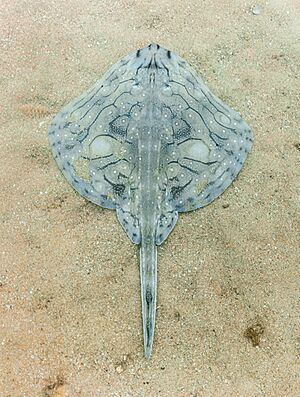Undulate ray facts for kids
Quick facts for kids Undulate ray |
|
|---|---|
 |
|
| Conservation status | |
| Scientific classification | |
| Genus: |
Raja
|
| Species: |
undulata
|
The undulate ray (Raja undulata) is a type of ray. It is a fish with cartilage instead of bones. You can find it in the Mediterranean Sea and the eastern Atlantic Ocean. Its home ranges from southern Ireland and England all the way down to the Gulf of Guinea. This ray usually lives in areas with mud or sand. It can be found as deep as 200 meters (about 650 feet), but it prefers shallower waters. Sadly, the undulate ray is considered an endangered animal because too many are caught by fishing.
Contents
What Does the Undulate Ray Look Like?
The undulate ray has a body shaped like a flat disc. The front part is triangular, and the back part is almost round. Its skin has special bumps called dermal denticles, which are like tiny spines. These spines help protect it.
Adult rays have scattered spines on their back. Young rays have them in a more regular pattern. Male rays have one row of spines on each side of their body. Female rays have three rows.
Its eyes are a medium size. Behind the eyes are small holes called spiracles. The mouth is on the underside of its body and is slightly curved. It has five pairs of small gill slits near its mouth.
The ray's tail is as long as its body. It has two dorsal fins (fins on its back) near the end of its tail. There are usually two small spines between these fins.
The color on its back can be light brown, yellow, or grey. It has darker wavy bands and many small white spots. The snout (nose area) and edges are often lighter with dark spots. Its underside is creamy-white with grey edges.
An undulate ray usually weighs about 10 pounds (4.5 kg). But it can grow to weigh as much as 22 pounds (10 kg) and be 100 cm (about 3.3 feet) long!
Where Do Undulate Rays Live?
This ray lives in certain areas of the northeastern Atlantic Ocean. It is found from southern Ireland and England down to Senegal. It also lives in the western Mediterranean Sea.
It's not common everywhere, but you can find many of them in some places. These include northwest Ireland, the eastern part of the English Channel, and near the south coast of Portugal. You can also find them sometimes in the northern Mediterranean Sea.
Undulate rays usually live on sandy, muddy, or rocky bottoms. They are found at depths of 50 to 200 meters (about 160 to 650 feet). This includes coastal areas and the upper part of the continental slope. Sometimes, they can be found in shallower water too.
How Do Undulate Rays Live?
We don't have a lot of information about how these rays live. Scientists think they can live for about 21 to 23 years. They figure this out by looking at growth rings on the ray's bones, similar to how you count rings on a tree.
Reproduction and Life Cycle
The undulate ray is an oviparous fish. This means the females lay eggs. They lay their eggs from March to September. Each egg is inside a tough, leathery black case with pointy corners. These cases are often called "mermaid's purses." Other rays, skates, and sharks also lay eggs in these cases.
The egg cases are usually about 72 to 90 mm (2.8 to 3.5 inches) long. They are also 42 to 52 mm (1.6 to 2 inches) wide. After storms, these "purses" often wash up on beaches. Usually, they are empty because the young ray has already hatched and swum away.
Studies show that female undulate rays reproduce more during the winter. Females also become mature and ready to have babies at a larger size and older age than males.
What Do Undulate Rays Eat?
The undulate ray eats small fish. It also enjoys eating crustaceans like crabs and shrimp. Other foods include molluscs like clams and snails. They also eat other small animals that live on the seabed.
Undulate Rays and People
Like other large fish that live on the bottom of the ocean, undulate rays are often caught by fishing boats. They are caught by accident or on purpose. Fishing boats use different tools like trawls (large nets), gillnets, and lines.
Undulate rays are also often kept in public aquariums. They tend to do quite well in these environments.
Protecting the Undulate Ray
The undulate ray is very sensitive to fishing. This is because they mature late and don't have many babies. Their numbers have dropped a lot in the north Atlantic, especially around Ireland. They are hardly ever caught in the English Channel anymore.
Because of concerns about their decreasing numbers, it has been against the law to keep undulate rays caught in EU waters since 2009. If a fisherman catches one, they must return it to the sea unharmed if possible.



